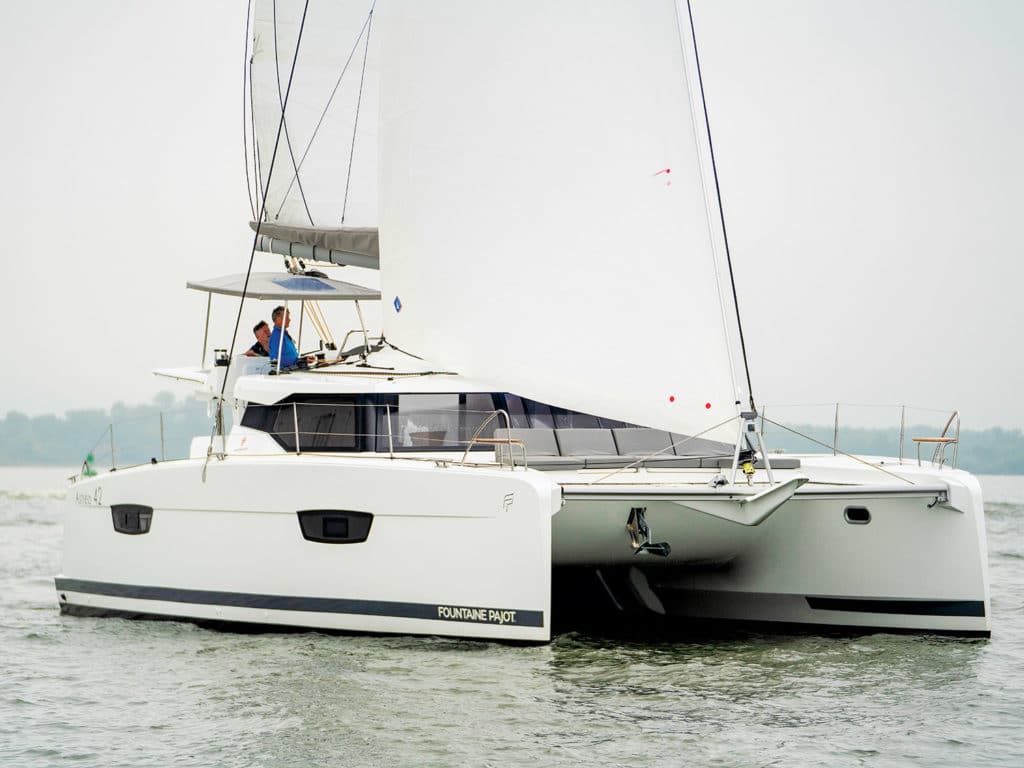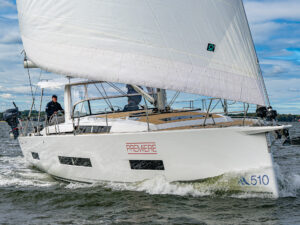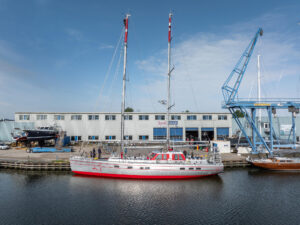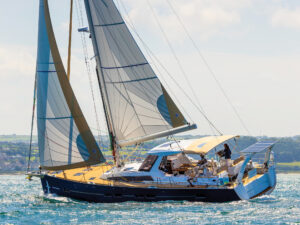
Based in La Rochelle, the French builder Fountaine Pajot has been crafting good-looking, well-designed, dependable cruising catamarans for over four decades now, and they have the drill down pat. I’ve always found their boats to be well put-together, fun to sail and with all the boxes ticked with regard to comfort, innovation and performance, both underway and with the hook down. Simply put, they’re cool cats. Their new Astréa 42 more than holds her own in the company’s wide range, which now extends from 40 to 67 feet.
It’s probably apparent that I’m a fan of the brand, but I’m not alone. When the company unveiled plans for the Astréa at the Cannes Boat Show two years ago, the following few months they took over 150 orders for the boat…before a single one was launched. By any measure, it was an immediate success.
It’s funny, with monohulls we’ve come to accept so-called “traditional” layouts: owner’s cabin with double berth forward; saloon with dining table centrally located; galley and navigation station to either side, respectively, of the companionway. But over the years, catamaran design has evolved in such a way that cats have established their own traditional accommodations plan as well: double doors connecting the saloon with the spacious cockpit; helm station raised to starboard; galley stationed aside the doors for convenience and entertaining; settee, dining table and nav station forward in the saloon; and sleeping cabins stashed in the hulls (often, with one hull reserved exclusively for the owners with a luxurious bed, small office, lots of storage, and a dedicated head and shower).
That’s the menu here, executed with an extra helping of French style and panache. I loved the arrangement of the raised helm station, with the space split between two compartments, or pods. The forward one contains all the sailing controls—the sheets, traveler and Lewmar winches, including an electric one for raising the hefty, square-topped mainsail. The aft pod is for the helmsman, and includes a bench seat for two, a full suite of Garmin instruments and autopilot, the engine controls, and even the buttons for raising and lowering the Quick windlass, because why not? Hop up a few steps, and there’s access to the sun deck and cushions on the coach roof which, come to think of it, has become another traditional feature for so many cat builders.
RELATED: Fountaine Pajot Saona 47
Likewise, the company has done a sensational job with the owner’s cabin that runs the length of the starboard hull and can be closed off into a truly private space. The queen berth aft is terrific, with easy side access. The centralized desk is a place where you could really get some work done. Storage closets and drawers abound. The separated head and gargantuan shower stall all the way forward would be the envy of many a high-end hotel. Once you’re aboard the Astréa, you’d need a really good reason to step off.
Fountaine Pajot is mindful of saving weight in the building process, as heavy cats are not lively ones. The infused hulls employ balsa core in the topsides, to just below the waterline; the injected decks are cored with foam. All the bulkheads are composite laminates, though Alpi wood is used for the furniture and trim. The small keels, which enhance tracking and stability, are sacrificial blades that are glued to the hulls, not bolted, so in the unfortunate event of a hard grounding, they’ll shear off and not compromise the vessel’s integrity. The engine compartments are vast and accessible. All the wiring is clearly labeled—though in French. Attention to detail has been paid throughout.
We test sailed the boat in light fall weather on Chesapeake Bay, when the breeze failed to rise above 6 knots. Still we had a nice sail, nearly notching 4 knots of boat speed both upwind and on a reach. The twin headsails provide some versatility in shifting gears in relation to wind speed and angle. My notes were simple: “Tight steering. Fun to drive.”
The Astréa we sailed, nicely equipped, came in at $645,000. Many new owners take delivery in France and initially explore Europe and the Med, sampling plenty of local cuisine, before sailing on. In so many ways, it’d be one tasty trip.
Herb McCormick is CW’s executive editor.








